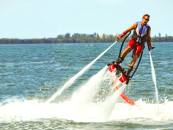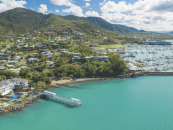Understanding the environment is an everyday practice, especially here on the Gold Coast. Our rich and blessed landscapes give us a lot to think about (and to be thankful for!). They are also a great advantage for our natural sciences teachers. After all, what could be a better way to teach about our waterways than sitting students on boats and pointing to the real objects of study? Here is another reason to love boating: relating our prior knowledge to the nature around us.
The Hero’s Journey
The important role of Australian naturalist David Fleay is the starting point of a program called, “The Hero’s Journey”, offered by Tallebudgera Beach School (TBS).
In the early 50’s, Fleay set aside a preservation area by the Tallebudgera estuary for its flood-free forested slopes and gullies, as well as its rich local biodiversity and many Aboriginal relics. After a few years (and a huge effort of Mr Fleay), the David Fleay Wildlife Park was founded in West Burleigh, the final destination for the students of Narangba State School from Brisbane, that were visiting TBS that week.
“The Hero’s Journey” involves not only the environmental awareness about waterways and the mangroves. It also helps students to find personal characteristics that can contribute to the group’s challenge, according to different passions and interests. “The canoes are part of students going on that journey to discover a little bit about themselves and trusting others whilst learning about the environment and waterways,” says Amy Park, a teacher of TBS.
Armed with their paddles, students have to cruise the channel to Fleay’s sanctuary, which also means, for many of them, leaving their comfort zone. “Digital technologies tend to keep students spending a lot more time in front of screens. It’s definitely starting to show that basic outdoor living rates are going down, and it may affect their physical abilities, their coordination,” Amy explains.
In fact, that was a windy morning and kids had to struggle a little bit paddling together to get to the park. But it was a fun activity anyway, and definitely worth it. When we arrived at Fleay’s sanctuary, we saw ourselves surrounded by the wide variety of trees, birds, snakes, koalas, crocodiles and many other species nested in the park.
“It’s all about interacting with the environment and being a part of it. The byproduct of today’s activity is that students discover a new skillset in relation to canoeing. And certainly today, with the environmental focus and the significance of looking after areas such as the Tallebudgera Creek, we educate the kids in the importance of these environments. It’s wonderful to take them out to see the real life, being a part of it,” explains Dale Mills, principal of TBS.
Mills also states that outdoor activities may require a higher level of responsibility as well. “The logistic to remove students from the classroom involves certain inherent dangers, so we need to ensure the staff is fully qualified for driving boats. That’s not a skillset that every teacher would have.”
A floating classroom
In northern Gold Coast, we boarded the Educat, a powerboat owned by the Jacobs Well Environmental Education Centre (JWEEC). The 12-meter catamaran was designed to take students to normally inaccessible study sites, uniting the convenience of a classroom with the fieldwork dynamism. The vessel is berthed at the Horizon Shores Marina and operates between Jacobs Well, Stradbroke Island, and Moreton Bay.
We cruised along with 11 students to learn about the mangroves of the area. The mission was to learn about the local flora and fauna, and the processes that affect the environment and its food chains. Onboard Educat, students have the opportunity to collect data on the water properties, such as temperature, salinity and depth, as well as observing the plants and animals captured by the trawl net attached to the boat.
“Today we are doing a sample trawl. As we have guidelines on how to handle the creatures, we record the information and release everything we catch alive. So, for students who have never been on a boat or done any fishing, this is a completely unique experience,” explains JWEEC’s Marine Programs officer, Peter Veijalainen.
For Steven Rowell, principal of JWEEC, practical classes are a great opportunity to make students feel themselves as agents of change: “All of our programs are experiential and students learn by doing. We hope each student leaves the program with a healthy knowledge and respect for the natural and cultural environment.”
By Daniela Grimberg
————————
TBS Canoes
The Tallebudgera Beach School canoes are made of fibreglass and were specifically designed with seats in the middle. These features not only provide extra strength and durability for daily use, but also the ability to seat two extra passengers, so it’s possible to have up to four students per canoe. The school also uses kayaks made of polypropylene, which is a lighter and a more durable material.
The Educat
Educat is a purpose-built boat 14 years ago and has the ability to drive up onto the beach and put people onto an island from a boarding ramp at the front, which makes it unique in a sense that not many other boats can do that. The boat is powered by twin diesel engines and its layout was designed as a large classroom, which can sit around 40 students.
The vessel can perform animal and plankton sample trawls and sediment grabs. Groups can also do snorkeling activities over the side. The maintenance of the catamaran receives good support from the local marina and is also used by university students in order to collect data for academic researches.
Besides Educat, JWEEC has two timber dories and canoes. The dories were built by students 25 years ago, based on an English fishing boat. They are able to get into very shallow waters and are safe watercrafts, so young students can get the opportunity to have a drive under staff supervision. The seven three-seat canoes are used on the Pimpama River and other confined waterways nearby. It allows students to sneak up on sea birds, kangaroos, snakes, ospreys, turtles and other species.
For more information:



























